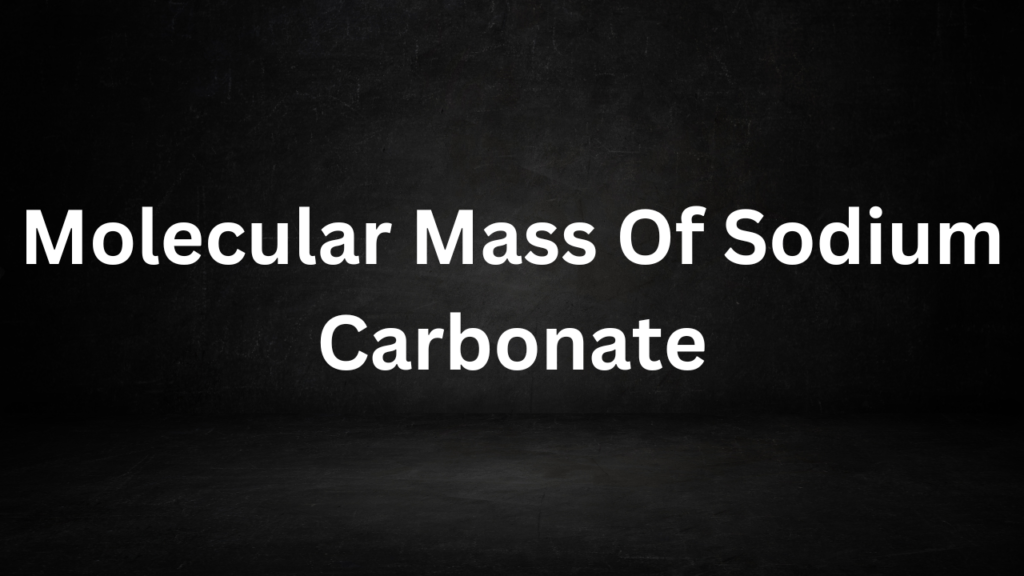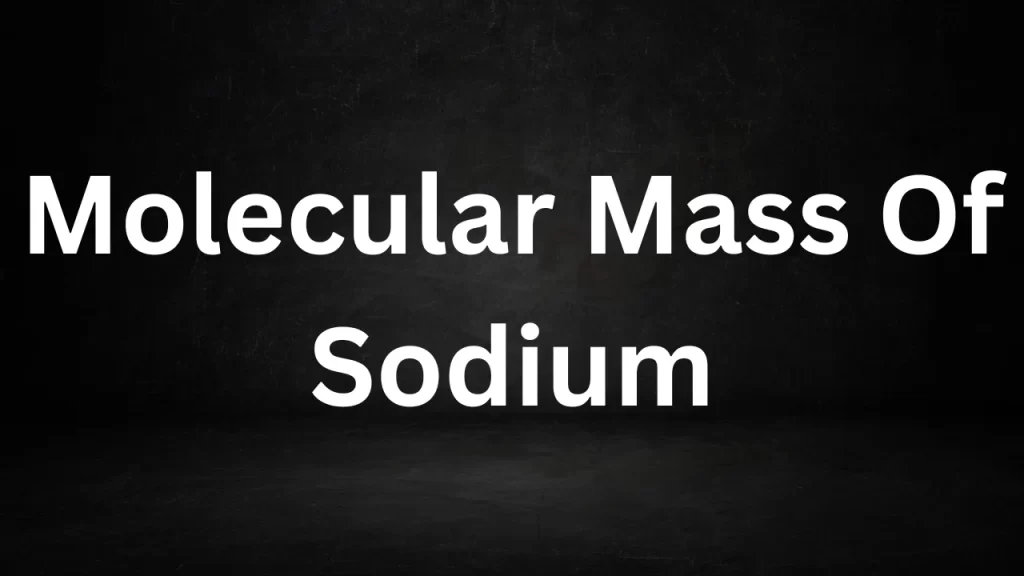Tag: molecular weight sodium carbonate
Molecular Mass Of Sodium Carbonate
Molecular Mass Of Sodium Carbonate: Sodium carbonate, also known as soda ash or washing soda, is a versatile chemical compound with numerous applications, ranging from household cleaning to industrial processes.
In the field of chemistry, understanding the mole mass of sodium carbonate plays a pivotal role in various calculations, especially those related to chemical reactions, stoichiometry, and solution preparations. In this article, we’ll explore molar mass, its significance in chemistry, and calculate the molar mass of sodium carbonate (Na2CO3).

Molecular Mass Of Sodium Carbonate
Molecular Mass: A Foundational Concept
The Molecular mass, also referred to as mole weight or molar mass, is a fundamental concept in chemistry. It denotes the mass of a single mole of a substance, commonly expressed in atomic mass units (amu) or unified atomic mass units (u). To calculate the molar mass of a compound, add the atomic masses of all its constituent atoms, considering their relative proportions.
Calculating the Molecular Mass of Sodium Carbonate
To calculate the mole mass of sodium carbonate (Na2CO3), we must first determine the atomic masses of the elements: sodium (Na), carbon (C), and oxygen (O), and then apply these values to the chemical formula.
- Sodium (Na): The atomic mass of sodium is approximately 22.99 amu.
- Carbon (C): The atomic mass of carbon is approximately 12.01 amu.
- Oxygen (O): The atomic mass of oxygen is approximately 16.00 amu.
Now, let’s calculate the molecular mass of sodium carbonate:
Molecular Mass of Na2CO3 = (2 × Atomic Mass of Na) + (1 × Atomic Mass of C) + (3 × Atomic Mass of O)
The Molecular Mass of Na2CO3 = (2 × 22.99 amu) + (1 × 12.01 amu) + (3 × 16.00 amu)
Molecular Mass of Na2CO3 = 45.98 amu + 12.01 amu + 48.00 amu
Molecular Mass of Na2CO3 = 105.99 amu
So, the molecular mass of sodium carbonate (Na2CO3) is approximately 105.99 amu.
Significance of Molecular Mass of Sodium Carbonate
The mole mass of sodium carbonate holds significant importance in various aspects of chemistry:
- Stoichiometry: Mole mass is crucial in stoichiometry, allowing chemists to balance chemical equations and determine the quantities of reactants and products involved in chemical reactions with sodium carbonate.
- Solution Preparation: In laboratories and industries, knowledge of the mole mass is essential for accurately preparing sodium carbonate solutions with specific concentrations, ensuring precise measurements.
- Industrial Applications: Sodium carbonate is widely used in industries such as glass manufacturing, detergents, and water treatment. Understanding its mole mass is vital for quality control and process optimization.
- Household Uses: Sodium carbonate is commonly found in household cleaning products, and its mole mass can help consumers understand product concentrations and efficacy.
- Safety: Knowing the mole mass of sodium carbonate is essential for handling it safely, especially in industrial and laboratory settings, as it assists in determining appropriate safety protocols and precautions.
Conclusion
The mole mass of sodium carbonate (Na2CO3) is a fundamental concept in chemistry, holding practical importance in various applications. Finding molar mass empowers informed choices, precise experiments, and optimized sodium carbonate use in various contexts. Comprehending this essential parameter amplifies our capacity to utilize sodium carbonate’s versatility across diverse chemical processes and applications.
Read More
- Molecular Mass Of Nitric Acid
- Molecular Mass Of Sulphuric Acid
- Molar Mass Of Sulphuric Acid
- Types Of Motion In Physics
- Kinetic Energy Class 9
Frequently Asked Questions (FAQs) On Molecular Mass Of Sodium Carbonate
1. What is the molecular formula of sodium carbonate?
The mole formula of sodium carbonate is Na2CO3, representing two sodium atoms (Na), one carbon atom (C), and three oxygen atoms (O) in a single molecule.
2. What does molecular mass or molar mass mean in chemistry?
Molecular mass, also known as molar mass, refers to the mass of one mole of a substance and is typically expressed in atomic mass units (amu) or unified atomic mass units (u). It is a fundamental concept in chemistry used for various calculations.
3. Why is the molecular mass of sodium carbonate important in chemistry?
The mole mass of sodium carbonate is essential in chemistry because it helps determine the quantity of sodium carbonate involved in chemical reactions, stoichiometry, and solution preparations.
4. How is the molecular mass of sodium carbonate calculated?
To calculate the mole mass of sodium carbonate (Na2CO3), you sum the atomic masses of all the atoms in its chemical formula, taking into account their respective proportions.
5. What is the molecular mass of sodium carbonate (Na2CO3)?
The mole mass of sodium carbonate is approximately 105.99 amu.
Molecular Mass Of Sodium
Molecular Mass Of Sodium: Sodium, with the chemical symbol “Na” derived from the Latin word “natrium,” is a chemical element that plays a crucial role in various aspects of our daily lives.
Understanding the molecular mass of sodium is fundamental in chemistry, as it helps scientists and researchers predict how sodium interacts with other elements and compounds. In this article, we will delve into the molecular mass of sodium, its significance, and its applications.

Molecular Mass Of Sodium
The Atomic Structure of Sodium
To comprehend the molecular mass of sodium, it is important to first explore its atomic structure:
- Atomic Number: Sodium is identified by its atomic number, which is 11. This signifies that a sodium atom contains 11 protons in its nucleus.
- Electron Configuration: Sodium has an electron configuration of 2-8-1, meaning it has two electrons in its first energy level, eight in its second energy level, and one in its third energy level.
- Isotopes: Sodium has several isotopes, but the most abundant and stable isotope is sodium-23 (Na-23), which has 12 neutrons in addition to its 11 protons.
Molar Mass vs. Molecular Mass
It is essential to differentiate between molar mass and molecular mass. Molar mass refers to the mass of one mole of a substance, often expressed in grams per mole (g/mol). Molecular mass (or molecular weight) typically refers to the mass of a molecule, which consists of two or more atoms chemically bonded together. Sodium, as an element, does not form diatomic molecules like hydrogen (H2) or oxygen (O2), so its molecular mass is the same as its atomic mass.
Calculating the Molecular Mass of Sodium (Na)
To calculate the molecular mass of sodium, we can use the atomic mass of sodium-23 (Na-23):
- The atomic mass of sodium-23 is approximately 22.99 atomic mass units (amu) or 22.99 g/mol.
- Therefore, the molecular mass of sodium (Na) is approximately 22.99 g/mol or 22.99 amu.
Significance of Molecular Mass in Sodium
The molecular mass of sodium is a crucial parameter with significant implications in various fields:
- Chemical Reactions: Sodium readily forms compounds with other elements, such as chlorine (NaCl) or oxygen (Na2O). The molecular mass of sodium is essential for stoichiometry, helping determine the amounts of reactants and products in chemical reactions.
- Biological Processes: Sodium ions (Na+) are vital in biology, playing a key role in nerve impulse transmission, muscle contraction, and maintaining electrolyte balance in the human body.
- Metallurgy: Sodium is used in the extraction of certain metals, such as titanium and zirconium, from their ores. Its molecular mass is relevant in metallurgical processes.
- Alloys: Sodium can be incorporated into alloys, such as sodium-potassium alloy, which has applications in heat transfer and cooling systems.
- Nuclear Reactors: In certain nuclear reactors employing liquid metal cooling systems, sodium serves as a coolant. The mole mass of sodium is important in the design and operation of such reactors.
Conclusion
Sodium, with a mole mass of approximately 22.99 g/mol or 22.99 amu, is a fundamental element in chemistry and biology. Its molecular mass is a crucial parameter in various chemical reactions, biological processes, and industrial applications. Sodium’s role in our daily lives extends from table salt (sodium chloride) to essential bodily functions, illustrating the significance of understanding its molecular mass and its behavior in various contexts.
Read More
- Molecular Mass of Sucrose
- Molecular Mass of Chlorine
- Molar Mass Of C2H5OH
- Molecular Weight of Co2
- Molecular Mass of Water
Frequently Asked Questions (FAQs) mole Mass Of Sodium
What is the mole mass of sodium?
The mole mass of sodium (Na) is approximately 22.99 grams per mole (g/mol) or 22.99 atomic mass units (amu). It represents the mass of one mole of sodium atoms.
How is the mole mass of sodium calculated?
The mole mass of sodium is calculated using the atomic mass of its most abundant and stable isotope, sodium-23 (Na-23), which has an atomic mass of approximately 22.99 amu or 22.99 g/mol.
What is the significance of knowing the mole mass of sodium?
Knowing the mole mass of sodium is important in various fields, including chemistry, biology, and industry. It is crucial for stoichiometry in chemical reactions, understanding the behavior of sodium compounds, and its role in biological processes such as nerve signaling and muscle contraction.
What are some common compounds of sodium?
Sodium forms numerous compounds, including sodium chloride (table salt, NaCl), sodium hydroxide (caustic soda, NaOH), sodium carbonate (soda ash, Na2CO3), and sodium bicarbonate (baking soda, NaHCO3), among others. These compounds have various industrial, culinary, and chemical applications.
Why is sodium important in biological processes?
Sodium ions (Na+) are essential in biological processes such as nerve impulse transmission, muscle contraction, and the maintenance of electrolyte balance in the human body. Sodium channels in cell membranes allow for the passage of sodium ions, facilitating electrical signaling.